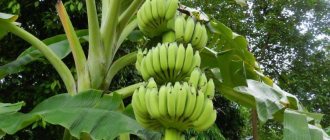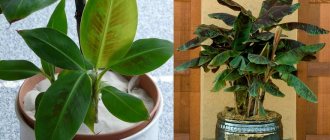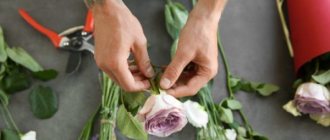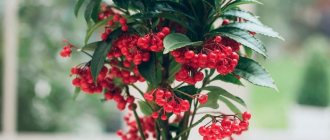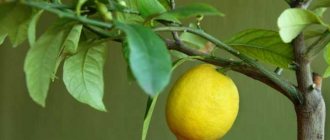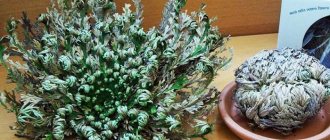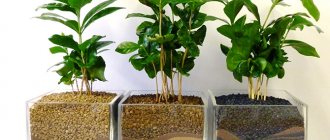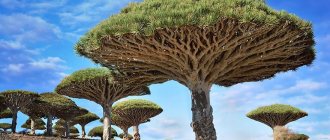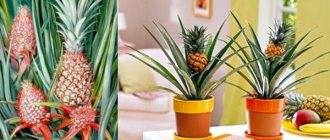A little about bananas
Now we will dispel another myth associated with bananas. This is not a palm tree, as many people think. This is a herbaceous plant, and a very large one, a perennial from the Banana family. The height of the plant can reach 9 meters. It is because of its large size that many people consider a banana to be a palm tree, although this is far from the case.
What people consider to be the trunk, the stems, are just the bases of its “leaves,” the petioles. And the true stem, also known as rhizome or rhizome, is hidden in the ground. It is very powerful and has a round shape. The leaves themselves are large, spreading, up to 3 m long. The color is green, but on the surface of each leaf there may be dark red colored inclusions.
On a note! The birthplace of the banana is considered to be Asia, Africa, Australia, and their tropical regions.
True, at home, even the tallest banana variety will not be able to grow more than 2 meters . And in general, dwarf varieties are usually bought for the home, which a priori will not be very tall. Banana is a monocarpic. That is, after the fruiting period, the entire leafy part of the banana dies off: only the part that is underground remains. But after a short time, the plant again forms new leaves. The lifespan of a banana rhizome reaches 40 years.
At home, bananas are most often grown for decorative purposes. If you grow it from seeds, the fruits will most likely turn out inedible - it will be a so-called uncultivated plant. But it will be resistant to various diseases. And if a banana is grown from a rhizome divided into several parts, then you can get a plant that retains all its varietal qualities and produces tasty fruits. This is how bananas are propagated on an industrial scale.
You can also buy a seedling in a pot. But in fact, growing bananas yourself is much more interesting.
Where did the banana come from?
Indian travelers saw how bananas grow in the wild for the first time in Malaysia. This happened earlier than the 6th century BC, and since then this fruit has often appeared in Buddhist writings. Everything indicates that it was during this period that the fruit began to develop “culturally” in India.
In 327 BC. the great conqueror Alexander the Great tried and appreciated their extraordinary taste. It is believed that he brought bananas from Asia and proposed growing them in Europe. In the 2nd century BC. Even the Chinese cultivated bananas, although until the 20th century this fruit was considered exotic.
Africa became acquainted with bananas during the difficult period of active slave trade and Islamic conquest (7th century). Another 700 years later, the sweet fruit was discovered by the Portuguese, who were famous for their love of travel. By the 18th century, bananas were no longer uncommon in many parts of the world.
It must be said that the original wild banana was very different from those that are now grown in countries for export. It was no larger than a human finger (hence the name, meaning “finger” in Arabic).
Which banana is suitable for growing at home?
Suitable varieties for growing at home include pointed banana, dwarf Kiev, superdwarf Kiev, cavendish dwarf or superdwarf . By the way, even at home they can bear fruit and produce tasty fruits with proper care.
On a note! Fruiting varieties often have variegated leaves - burgundy spots on a green background in young plants.
And the varieties that are most often chosen for decorative purposes are lavender banana, Chinese dwarf banana, velvety or bright red banana . They bloom beautifully, but do not produce edible fruits; they contain more seeds than pulp.
Advice! In order to get banana fruits at home, we recommend taking the Kiev dwarf variety. It bears fruit at 3 years old and produces fairly large, sweet fruits.
Almost all such varietal bananas will have to be purchased in the form of seeds in the store. They say that their germination rate is not the highest, but it is still possible to grow the plant. The exception is fruiting varieties. There you will have to buy a cutting somewhere on a forum for true connoisseurs of exotic plants. You can bring a cutting from some tropical country, but when buying it there, explain that you need a dwarf version. To transport such a plant to our country, you will need to issue a special phytocertificate.
But if you don’t want to bother with varieties, then just buy any banana in the store and use it to grow a houseplant. He will also fit in just fine.
Where do bananas grow?
Let's move on to the question of which countries bananas grow in. This plant prefers to grow in warm tropical climates, so the main producing countries are in:
- Africa;
- Pacific Basin;
- Caribs;
- Latin America.
Of these, only Latin America exports bananas; the rest of the countries maintain banana plantations for domestic consumption. Therefore, more than 80% of fruits supplied to the CIS are grown in Brazil, Argentina and other neighboring countries.
In terms of total production and consumption, the Philippines, India and China lead. This is explained by the fact that agriculture there is more developed than industrial production. But the answer to the question of whether bananas grow in Russia is only partly positive. Several plantations are located in the southern part of the country, outside the city of Sochi and in Crimea. However, there is a special species whose fruits are red.
Planting material
Let's figure out how to get planting material from bananas. Remember that the store often sells unripe fruits. This way they are able to survive transportation from southern countries to us. Therefore, in order to get suitable seeds, we will first have to let the banana ripen and the seeds ripen. We select the smallest, yellowest fruit from the entire branch, wrap it in a bag and put it in a warm place. And wait for the banana to completely darken. Then you can remove the seeds from it and use them for sowing.
→ Is it possible to freeze bananas and how to do it?
Manzano
Manzano bananas are also unusual - their fruits are reddish-brown and, when ripe, blackish or dark burgundy in color. Yellow color, unlike most bananas, indicates that the berry is unripe.
The manzano fruit has a light apple-strawberry flavor. Its pulp is tougher than that of a regular berry and tastes like an apple (hence another version of the name - “apple”). Among bananas, this variety holds the record for vitamin C content: 100 grams of pulp contains a quarter of the daily dose required by a person.
Manzano is eaten both fresh and used in the preparation of various dishes. Another distinctive feature is that the pulp practically does not darken in air. This allows it to maintain its aesthetic appearance for a long time, which is why this variety is used for preparing salads and a variety of desserts.
These bananas are native to Central and South Africa. And the largest supplier today is Costa Rica.
How to grow a banana at home: step-by-step instructions
So, let's see how to grow a beautiful bush at home from ordinary store-bought bananas. You will need the bananas themselves, a cutting board, a sprayer with water, a strainer, a small plastic tray, some toilet paper or napkins, a knife and, of course, soil.
Step 1 . Cooking bananas. It is better to take smaller fruits, since there is a greater likelihood that a plant will grow from their seeds. But from large bananas it is rarely possible to obtain seeds with good germination. We remove the selected fruits into a plastic bag and put this bag in a dark and warm place. Leave the bananas there for about 3 days until they darken.
Step 2 . We remove the skin from the banana and throw it away, it will no longer be useful. Next, divide the banana pulp into three parts. Please note that the body of a banana consists of three segments, they are easy to see if you look closely at the pulp. It is according to these segments that the fruit needs to be divided.
Step 3 . Let's look at the inside of the banana segment closer to the stalk, that is, to the bottom of the fruit. This is where banana seeds are found.
Step 4 . Carefully, using a sharp object (for example, a knife), remove the seeds from the pulp. They are very tiny and it is not possible to completely remove the pulp from them - we take a small amount of it together.
Step 5 . Spread the seeds with the remaining pulp on the spread toilet paper or napkin.
Advice! Look carefully at the seeds and remove any that are flat in shape. Only round specimens are suitable for planting.
Step 6 . Cut a strip of paper with seeds on it. We don't need the rest of the paper.
Step 7 . We pour the prepared soil for seedlings into a small plastic tray, on top of the previously laid drainage layer. The soil should be light: a mixture of peat and sand (1:3) is suitable. Moreover, even before planting, it is important to spill boiling water on the soil so that it is safe for future seedlings, and phytosporin to saturate it with useful substances.
Step 8 . We place our paper strips with seeds on the surface of the soil, and on top, using a sieve, sprinkle with soil. The layer of soil with this method of germination is about 0.5 cm.
Step 9 . After this, spray the soil with water from a spray bottle.
Step 10 . Next, we close the tray with a plastic lid, creating greenhouse conditions, and place the mini-greenhouse on a radiator or in another warm place. The optimal temperature is 27-33 degrees during the day and not lower than 20 degrees at night. Once the seeds have sprouted, the lid can be removed and the tray exposed to light.
Important! Do not rush banana seeds - they sometimes take a very long time to germinate, up to 2-3 months. Be patient, periodically ventilate the greenhouse and moisten the soil. If mold appears on the surface of the substrate, spray it with a weak solution of potassium permanganate.
Caring for banana seedlings is the same as caring for other tropical plants. They need to be protected from drafts, provided with a warm and humid environment, but not flooded - excess moisture is dangerous for bananas. We simply remove all weak bananas, leaving only strong leaves. As soon as the leaves gain strength and get stronger, and each seedling has a pair of leaves, they can be planted in separate pots.
By the way, there are other ways to germinate and plant banana seeds . For example, some gardeners prefer to thoroughly rinse the seeds from the pulp, and then fill them with warm water and keep them in it for up to 2-3 days, after which the planting material is washed and dried.
Banana seeds have a hard skin and can be scarified . This is a procedure that helps to break the integrity of the shell. For example, the seeds are simply laid out between two layers of sandpaper and lightly rubbed. Do not be zealous - there is a risk of damaging the seed itself.
Only after this are the seeds sent for germination in some inert substrate - for example, sphagnum or coconut. Moreover, the planting material is simply pressed into the substrate, without even being sprinkled with anything on top.
→ TOP 5 ways to keep bananas fresh longer
Video - Growing bananas at home
How to collect
In most cases, banana fruits are harvested while still unripe so that they ripen during transportation. The fruits do not always have time to ripen, so in supermarkets you can still find greenish fruits, which, after purchase, reach the condition at home.
Let's look at the fruit harvesting process using the example of a banana plantation in Costa Rica:
- As soon as the ovaries begin to grow on the bunch, a plastic cover is immediately put on them - protection from external damage, due to which the fruit will deteriorate even before cutting. The ovaries develop in the sheaths for 11 weeks. This is not full ripening of the banana, but sufficient for picking and transportation. The fruits are cut and hung on a special cable car, along which they are sent to the packaging site.
- The work of collecting bananas is not difficult; only two people can do it. The first cuts off a bunch of fruits with a cleaver tied to a long stick, the second puts the bunches on his shoulders.
- The plant from which the fruit was collected is cut down - it will no longer grow or bear fruit. A fresh sprout is immediately planted in the same place and grows until the next harvest.
- At the packaging station, the bunches are laid out for 20 minutes in a tank with running water until the juice stops oozing from the cuts - otherwise the presentation will deteriorate.
- At the packaging station, the fruits undergo special control, and usually no more than 6% of the product is eliminated. The “rejects” are not thrown away, but put into production - for baby food or baking banana bread.
- The fruits are washed thoroughly. This is what women do.
- After being removed from the water, the bunches are dried, wrapped in plastic film, placed in branded boxes and sent for sale. Transportation most often occurs by sea - it is more convenient and cheaper.
From Costa Rica, goods travel 10 days to the United States, 20 days to Europe. Therefore, more bananas are placed in “European” boxes, since the fruit will dry out slightly during the journey. Depending on the exporting countries, be it Africa, Ecuador or the Canary Islands, delivery conditions and terms may be different.
Banana care at home
Despite some difficulties with growing bananas from seeds, in general this plant is unpretentious and not capricious, perfect for amateur gardeners. It is quite easy to care for it.
Any neutral soil But some advise choosing a composition based on sand, leaf soil and peat (1: 2: 2). The soil must be regularly loosened to a depth of 2 cm so that it is airy. Don’t forget about drainage: bananas don’t like being waterlogged, so choose a thicker drainage layer, about 3 cm.
feed a banana no more than once every 2 weeks. In general, he loves any kind of fertilizing, but most of all he prefers organic matter: vermicompost, infusions made from herbs.
What a banana needs like air is light . It is better to place the plant where there is maximum light in your home - on the eastern, south-eastern window. The plant can also be illuminated with a special lamp (in winter, during short daylight hours, this is necessary). Remember that if there is a lack of light, the plant will develop poorly, will not bloom, or even die. In summer, a banana can be taken out to the balcony, but it is better to protect its leaves from direct sunlight (you can use curtains).
The optimal temperature , as for seeds, is 25-30 degrees. If the apartment is noticeably colder, the growth of the plant will slow down greatly. And in general it is better to protect it from temperature changes and drafts.
Watering is carried out as the substrate dries to a depth of 2 cm, not often, but abundantly, that is, until water appears in the pan under the pot. There is no need to pour water out of it after watering. You also need to spray the leaves: in winter - once a week, in summer - daily, ideally. In winter, watering should be slightly reduced: it is important to ensure that the banana roots do not rot, this is the most difficult period.
On a note! If you forget to water a banana, then tragedy will not happen. The plant may be without water for some time. But you shouldn’t forget about watering often - this will negatively affect the development of the banana.
It is not necessary to plant bananas in large pots. For plants from 10 to 20 cm, you can take a container of 1-2 liters, and for bushes about 60 cm in height, a pot of 12-15 liters is suitable. But as soon as white roots appear from the drainage holes, you know that it’s time to replant. Choose a pot that is about 5 cm larger in diameter than the one in which the banana lived before replanting. If white roots appear on the surface, simply sprinkle them with soil. Bananas are replanted only using the transshipment method. The first couple of days are protected from intense light, and then the pot is placed in the same place where the banana grew.
By the way, it is important for bananas to receive oxygen in the root area. This means that fresh air must also enter through the drainage holes. To do this, place the banana pot on a plastic mesh placed in a tray. This will increase the amount of air reaching the roots.
Fruiting is what is most difficult to achieve from plants in apartment conditions. It is believed that a banana bears fruit when it grows to a pot of about 40 liters. Remember that as soon as the banana flowers and fruits, its above-ground part will die off - this is normal and there is no need to panic. In the near future, fresh leaves will appear above the surface of the soil.
Bananas can bloom all year round. The plant will have to be pollinated manually, although in nature this is usually done by bats.
→ Is a banana a fruit or a berry? Or maybe grass? Find the answer here
Types and varieties of bananas
Although there are depressingly few varieties of this fruit on Russian shelves, there are dozens of them all over the world. Fruits vary in shape, color, size, taste, and calorie content. Some varieties contain oil, which is actively used for cosmetic purposes.
Banana fruits are divided into narrower groups into subcategories.
Decorative bananas
An inedible banana can grow in an apartment as an ornamental plant. The appearance is impressive - a tall lush tree with a green mass of leaves up to 2 meters high. It bears fruit, but the fruits are green and frost-resistant. The most common varieties of ornamental banana are lavender, scarlet and velvet.
Sycamore plantains
Plantain is the so-called “vegetable banana”. In many ways, this variety is similar to the popular dessert fruit, but it is grown and eaten very differently. Plantain has been bred artificially as a cheap, high-carbohydrate food for the world's poor.
The tree grows larger and more resilient, less sensitive to drought. However, plantain grows and bears fruit well in humid climates and rich, developed soil.
Dessert bananas
The dessert fruit is yellow in color and is used in dishes without prior heat treatment. In addition, they can be collected dried or pressed. The most popular variety is the paradise banana. The plant reaches nine meters in height. The leaf reaches two meters in length and is light green in color with distinct brown spots.
The fruit itself is usually five centimeters in diameter and up to twenty centimeters in length. The pulp is tender, compact, almost white and seedless. Up to 300 fruits grow on one stem. These are the fruits that we see in stores. They all grow as a result of artificial selection.
How to distinguish fodder bananas
In Russia, the above-mentioned plane tree is considered the only forage variety. The name is always indicated on the packaging. If the packaging is not visible, the food fruit can be recognized by its size (long, large, at least 4 cm in diameter) and distinct longitudinal “ribs”.
This species is collected and sold unripe, as it turns black when ripe. Plantain fruits are more starchy and therefore have a higher calorie content.
Problems during cultivation
If you properly care for a banana, the plant will not get sick and is rarely affected by pests. But let us indicate some signs that not everything is in order with the plant.
- Drying leaves and a brown border indicate overwatering of the plant and rotting of the roots. It is necessary to replant the banana as quickly as possible, while removing the affected part of the rhizome. The sections are sprinkled with activated carbon.
- Drying leaves may also indicate low air humidity or a decrease in temperature. Just change the banana growing conditions: use a humidifier or regular misting.
- Sometimes the plant is affected by spider mites - white dots appear on the leaves, then the leaf dies. Sometimes thin cobwebs can be seen on the leaves. Remove the affected leaves and wipe the rest with soapy water, treat the plant with insecticides. After a week, carry out the treatment.
Articles on the topic
Banana varieties
In addition to the banana of paradise, with the fruits of which we are well familiar, there are many varieties of this plant - in other words, the banana family is quite large. Today, approximately 200 varieties of this fruit plant are known. Among them there are edible, decorative and even technical ones, the leaves of which are used to produce fiber. The pulp of edible bananas is eaten fresh, as well as fried and dried. They also make marmalade and jam from it, and prepare syrups and wines. Bread is made from the powder of some mealy banana varieties.
The colors of grown bananas are mostly yellow, but in a variety of varieties there are blue, red, and white-green, as well as bananas with stripes and those having a rectangular (usually square) cross-sectional shape.
Let's look at just a few species of this plant for clarity.
Cultural forms of basho banana
Some cultivated forms of Basho banana available commercially:
- 'Fuji-Yama' is a variety bred in Holland and the most widespread in Europe.
- 'Fuji-Yama Variegata' is another variety recently developed in Holland by Jos van der Palen. It is not yet widely used.
- 'Tchechenia' is a variety bred in Chechnya.
- 'Sakhalin' is another variety based on clonal material obtained from Russia. It is characterized by high cold resistance. Compared to 'Fuji-Yama' the leaf color is darker and the cuttings are thicker.
- 'Sapporo' is a cultivar similar to the 'Sakhalin' variety, from the north of Japan (named after the city of the same name on the island of Hokkaido), frost resistance down to -19°C with standard methods of protection from the cold. It is sometimes erroneously called Musa saporro, but this variety does not have scientific status as a species or even a subspecies.
- 'Nana' is a dwarf form of unknown origin. It grows no higher than 3 m. In recent years, it has become increasingly popular in Central European countries as a garden ornamental plant. The leaves freeze at -3°C and require shelter in winter.
Data on the hardiness of these varieties should not be taken literally, because a comparison of their merits under the same growing conditions has never been carried out. Although the names of the varieties correspond to the names of the area where the seedlings were obtained, it is not their homeland. At one time, all these plants were brought there from China.
Care and reproduction
Bananas are often demanding on lighting . They like bright light, but in winter they need additional lighting. Such plants love warmth, so they should be kept at a temperature of 16-30 degrees. Air humidity must be high, otherwise the plants will lose their shine.
In spring and summer, watering is carried out abundantly, and fertilized in September. Planting should be done deeper than the initial planting.
Reproduction is possible by suckers, seeds, and division of rhizomes. Plant diseases and pests include :
- mealybugs;
- root rot;
- spotting;
- scale insect;
- thrips;
- spider mite.
What are the benefits of banana?
Everyone loves bananas, but the best part is that it is not only tasty, but also healthy.
They are considered sources of a large number of microelements that have a beneficial effect on the human body.
They contain many useful substances , namely:
- vitamins of group B (B1, B2, B6), C and PP;
- beta-carotene, calcium, potassium, iron, fluorine and phosphorus;
- serotonin, tyramine and dopamine.
This set of useful microelements allows you to reduce the level of “bad” cholesterol, normalize the functioning of the gastrointestinal tract and cardiac system, and also have a beneficial effect on the central nervous system.
Benefits of bananas
Eating bananas allows you to:
- Relieve muscle spasms during physical activity.
Some athletes experience discomfort in the body in the form of cramps and pain, which may be due to a lack of potassium in the body. In this case, a banana is an excellent source of the missing trace element, so you can add it to your diet at least to alleviate these symptoms.
- Improve sleep quality.
The melatonin content in bananas makes it an excellent snack a few hours before rest. This natural hormone influences your wake cycles, actually promoting your sleep.
- Monitor blood pressure.
Of course, the effect of eating a banana is not comparable to the effect of medications. However, it is rich in iron, potassium and magnesium, so it can normalize hemoglobin levels in the blood and lower blood pressure.
- Reduce acidity in the stomach.
Banana is recommended for use for gastritis and frequent heartburn, as it has an enveloping effect and thus protects the mucous membrane from the aggressive action of hydrochloric acid of gastric juice, reducing discomfort in the gastrointestinal tract.
- Remove excess fluid and toxins from the body.
- Cheer up.
It is believed that when eating a banana, the body produces the so-called pleasure hormone. That is why this fruit is recommended to be added to the diet of women with PMS or simply in a bad mood.
Banana is a healthy product in the diet of both adults and children. The latter are suitable as first complementary foods, as these fruits are hypoallergenic and suitable for any age. In addition, they are excellent for the diet of athletes and all those who lead an active lifestyle.
Is there any harm?
Bananas are absolutely harmless, but for some people they are still contraindicated. In particular, it is not recommended to use them:
- For inflammatory processes of the stomach. In addition to the fact that a banana can intensify a painful symptom, it can also lead to flatulence in humans.
- Overweight people. Bananas contain a lot of carbohydrates (22 g for every 100 g of fruit) and are digested quite slowly. That is why they should not be abused by people prone to excess weight.
- For those who have problems with blood vessels. Banana can thicken the blood and increase its viscosity, which, in turn, can result in thrombosis of veins and arteries.
- In large quantities for men. It is believed that increased blood viscosity slows down blood flow to the genitals, which can lead to problems with potency.
In addition, you should not eat bananas immediately before eating other food to avoid a feeling of heaviness in the stomach and bloating. However, they should not be consumed on an empty stomach. The best time is an hour after the main meal (lunch or dinner) as a lunch or afternoon snack.
Is banana a fruit or berry?
Before we could stop being surprised that watermelon is a real berry, a new dispute arose among the people. What is a banana? What is a fruit, a berry or even a vegetable? If you answer this question without thinking, many will say that the first option is the only correct one, and there will be a grain of truth in this.
Indeed, a banana is a fruit in the culinary and everyday sense . We are accustomed to thinking that berries are sweet, but small fruits of plants, and fruits are large. This leads to the following conclusions.
However, if you delve deeper into botany, then everything turns out to be not so simple. According to plant science, both a fruit and a berry are a fruit, that is, a reproductive organ that is formed from a flower that contains seeds. However, the difference between them is significant.
Berries are fruits with a thin shell, juicy pulp, and small (often dense) seeds inside. Grapes, currants, raspberries and even, oddly enough, tomatoes fall into this category.
As for fruit, this is rather a household term: it refers to any edible fruit of a tree or shrub, usually large in size.
It is harder to notice the seeds in store-bought bananas than in wild fruits, but they are there. So it turns out that they meet all the criteria for berries and are such according to all the “laws” of botany.
However, calling them fruits in everyday life would also not be a mistake, so there is no definite correct answer to this question. By the way, you can’t call a banana a vegetable. Because its fruits are the result of the ovary of a flower, and this is a clear sign of belonging to the category of fruit.
What kind of plant is this?
A banana is a herbaceous plant on which the fruits of the same name ripen. Even though the plant looks like a tree, it is a grass. Moreover, it is quite tall, the second tallest after bamboo.
Banana grass is called because of the absence of wood on the above-ground part of the plant. In fact, the trunk (it would be more correct to say “false trunk”) is formed by the leaves superimposed on each other. It is not surprising that in this case it does not have growth rings and branches. Over time, the banana leaves that form the trunk dry out, acquire a brown tint and, indeed, resemble a trunk more and more.
The herb belongs to the banana family, genus banana. It has branched rhizomes that spread over a distance of up to 5 m and can go 1-1.5 m deep into the soil. The banana is often called a tree because of its high false trunk, which reaches 2-12 m and has a diameter of up to 40 cm.
The banana also boasts impressively sized leaves - they reach 3 m in length and 1 m in width. These are “ovals” with a pronounced longitudinal vein and many thinner veins extending from it.
By the way, during a strong wind, the leaves tear along the veins, which reduces the pressure on them and eliminates the threat of the plant being torn out of the ground by a strong gust of wind.
Leaf color can vary significantly depending on the plant variety. There is grass with dark and light green leaves, sometimes with purple spots on top of the green color. There are varieties that are characterized by two-color leaves - they are crimson below and bright green above.
These huge leaves have a waxy coating on the outside, which prevents excessive evaporation of moisture from the leaves. As they age, the leaves fall off, and in their place new ones appear from the axils of the trunk. On average, it takes a week for a new leaf to develop.
The plant is often called a banana palm, due to some external similarity between the plants. However, such a classification is erroneous - the banana has nothing in common with palm trees.
The banana grows in areas with a tropical and subtropical climate. The world's largest suppliers of bananas are Pakistan, India, China, Thailand, Bangladesh, and Brazil. Under natural conditions, it is possible to grow the crop near Sochi, but winter temperatures here are still too low for it.
Today, about 70 varieties of bananas are known, all of them can be classified into one of three groups.
Decorative
These plants are cultivated not for their fruits (they are inedible), but for their attractive appearance, especially during the flowering period. In addition, the leaves and elements of the false trunk are used in industry - they are used to make car seats and fishing gear.
Among the most famous ornamental varieties are the following:
- “Pointed banana” has beautiful dark green leaves with serrations, thanks to which the leaf resembles a bird’s feather, bears fruit in warm climates, and the fruits can be eaten;
- The Blue Burmese Banana has an attractive silver-coated purple-green trunk, rich green leaves, and purple or blue-skinned fruit.
Plantano
Bananas of this variety grow large and are suitable for eating, but usually require heat treatment. Such fruits are fried, baked, deep-fried, dipped in batter. By the way, it is from these varieties of bananas that banana chips are made.
Since platano fruits are quite dense, they are subjected to heat treatment, but the ripe peel can be eaten fresh. To do this, you should choose sycamore with black peel.
Unlike dessert bananas, platanos have denser, unsweetened flesh and a dense skin. In addition to being eaten, they are grown as livestock feed.
In turn, bananas of the platano variety are divided into 4 groups - French, French carob, false carob and carob.
Dessert
Bananas are well known in our country and can most often be found on store shelves in fruit departments. They are consumed fresh, but the pulp of such bananas can also be dried and dried.
Among the most famous dessert varieties are “Paradise”, “Gros Michel”, “Ice Cream”. Miniature bananas are the “Lady Fingers” variety (fruit length is 10-12 cm).
Possible diseases and pests, ways to get rid of them
If careful, high-quality care is provided for a banana, the plant is extremely rarely exposed to any diseases. Most often, gardeners when growing such crops are faced with gray rot.
This is a fungal infection that occurs and develops due to excessive amounts of moisture in the soil. To determine if there is a problem, you just need to inspect the plant. If the crop is infected, a gray moldy coating will appear on its trunk and leaves.
To cope with rot, you will need:
- Trim off infected areas.
- Completely replace the soil with fresh one.
- Treat the entire plant with copper sulfate. Foundationazole (2%) is also suitable for this.
There are also rare specific fungal diseases of banana.
The table will help you understand them:
| Disease | Peculiarities |
| Panama disease | When disease occurs, the leaves turn yellow and the stem bends. The trunk gradually changes color to red and splits |
| Black Sigatoka | The leaves first become covered with brown spots. Later the latter turn purple. Bananas grown on an infected crop are inedible - very sour |
| Moko's disease | The leaves of the plant turn yellow and wither, the fruits wrinkle. Bananas fall off quickly |
If a plant is found to have one of the listed diseases, it will be very difficult to cure it (they are highly resistant to all antifungal drugs known today). The only option is to completely destroy the banana.
The fruits of the plant under discussion have a bright aroma and sweet taste. Therefore, it attracts a large number of insects. Some you have to deal with even at home. For example, these are nematodes. Such miniature worms enter ripening fruits through roots in the soil. Nematodes lay their eggs there.
It is difficult to notice the problem just by inspecting the plants. But there are some reliable signs of the disease that are important for every gardener to know. These are, for example, black dots on the leaves, which gradually merge into one large spot. Signs of the disease also include cessation of plant growth, yellowing and wilting of leaves, thickening on the trunk and roots.
The problem most often arises due to poorly prepared soil for planting. The use of fresh manure as fertilizer can also lead to the appearance of nematodes.
To deal with the problem, you will need:
- Completely replace the soil with fresh one.
- Disinfect the containers in which the banana will continue to grow.
- Trim parts of the roots with thickenings.
- Soak the remaining roots in hot water for half an hour. The optimal temperature is 45 degrees.
- Treat the entire plant with the medicinal composition. For example, the drug "Vermox", "Bazamid".
The already treated diseased plant should be removed away from any others for about 15 days. During this period, it is best to send the crop to peat.
Another commonly encountered insect is the black weevil. It lives in the soil and feeds on plant sap. The parasite moves in the roots of the crop and leaves behind passages with sticky traces. To determine that the plant is infected, jagged marks on the edges of the leaves will allow you to determine.
The following steps will help you cope with the problem:
- replacing the soil with fresh, uncontaminated soil;
- washing the plant with a cloth with soap dissolved in water;
- treatment of the plant with drugs against parasites (Fitoverm, Aktara).
New soil should be set aside for 3-4 days. It is covered with a film to prevent new insect eggs from getting into the mass.
Another common problem is spider mites. Its appearance on the plant can be immediately noticed. At the same time, the leaves turn yellow and crack over the entire surface. If you turn the leaves over to the other side, you will notice thin cobwebs there. An infected banana stops growing.
To cope with the disease, the plant must be thoroughly rinsed under running warm water in the shower (but not hot). Afterwards, remove all adult insects on the crop with tweezers or other suitable tools.
All that remains is to treat the affected plant with any suitable preparation. For example, “Fitoverm”. An excellent prevention of the problem is the use of an ultraviolet lamp. Treatment for 2-2.5 minutes once a week is sufficient.
Fruit bananas (the fruits of which can be eaten)
Grown for its abundance of tasty fruits. Developed from two known species: Banana Balbis and Banana acuminate. Popular varieties are:
A low-growing variety with dense pale green leaves. The flower is bright red. Fruits abundantly.
Dwarf Cavendish banana (Musa acuminate Super Dwarf Cavendish)
Low fertile variety. The bright green leaf blades are wide and large. Burgundy flower.
It is still rarely found in apartments. Fans of indoor exotics like the plant with its powerful silhouette, large leaves and spectacular flowers. The giant plant looks good in a spacious room with high windows. Large space allows the plant to develop harmoniously and emphasizes its uniqueness.

